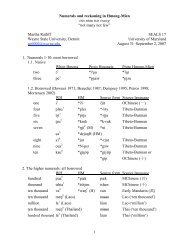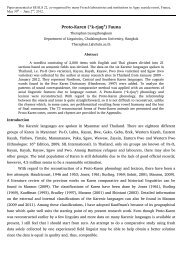proto-southwestern-tai revised: a new reconstruction - seals 22
proto-southwestern-tai revised: a new reconstruction - seals 22
proto-southwestern-tai revised: a new reconstruction - seals 22
Create successful ePaper yourself
Turn your PDF publications into a flip-book with our unique Google optimized e-Paper software.
Vietnamese Passive 107<br />
Lê Xuân Thại (1989) also has a similar view when he claims that even though<br />
Vietnamese does not have passive sentences completely similar to those in inflecting<br />
languages, it does have sentences which could be characterized passive with the following<br />
characteristics:<br />
- The subject denotes patient rather than the agent.<br />
- The predicate is appended by được or bị.<br />
- The predicate may be followed by a clause. For example:<br />
(1) Em học sinh này được cô giáo khen<br />
adr. student this get teacher appraise<br />
This student is appraised by the teacher.<br />
(2) Thành phố Vinh bị máy bay giặc tàn phá<br />
city Vinh suffer airplane enemy destroy<br />
Vinh city is destroyed by enemy planes.<br />
He also acknowledges that được, bị could be absent from passive sentences, for example:<br />
(3) Bữa cơm dọn ra<br />
meal set out<br />
The meal (is) set out.<br />
(4) Ngôi nhà này xây bằng gạch<br />
house this build by bricks<br />
This house (is) built of bricks.<br />
Diệp Quang Ban & Nguyễn Thị Thuận (2000) also support the existence of passive<br />
sentences in Vietnamese. They argue that the passive voice in Vietnamese is not marked in<br />
the form of verbs but in the form of a special syntactic construction with established<br />
grammatical and semantic characteristics. Accordingly, they specify the following<br />
characteristics of Vietnamese passive constructions:<br />
- The appropriate grammatical means for expressing passiveness in Vietnamese are<br />
function words (được, bị) and word order.<br />
- Verbs participating in passive constructions are transitive verbs which have<br />
semantic relations with entities expressed by noun phrases as subjects before<br />
được, bị.<br />
- Semantically, passive sentences have the following structure: i) The subject of the<br />
passive is assigned to the semantic roles of patient, recipient, goal, beneficiary. ii)<br />
The types of states of affairs of passive sentences are actions with two semantic<br />
characteristics: [+dynamic] and [+control].<br />
- Syntactically, passive sentences have two clauses in their construction:<br />
C-V [C-V].





